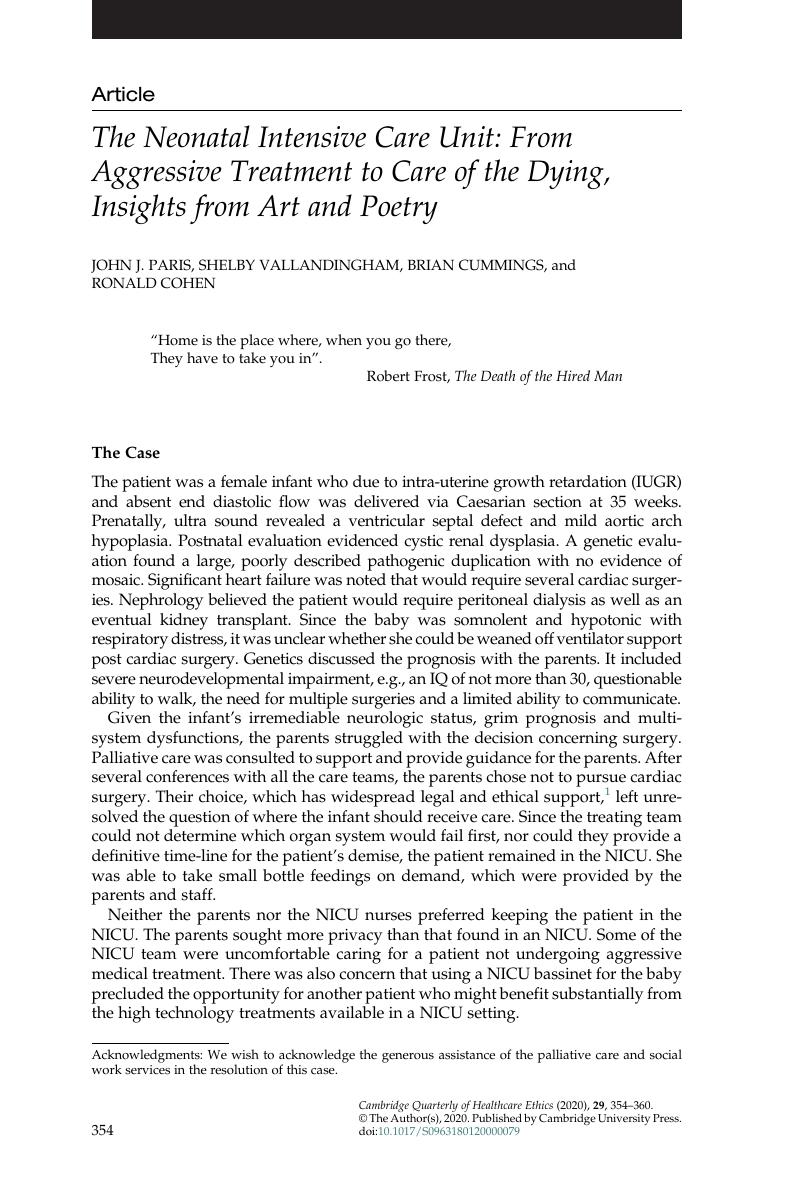No CrossRef data available.
Published online by Cambridge University Press: 02 June 2020

Acknowledgments: We wish to acknowledge the generous assistance of the palliative care and social work services in the resolution of this case.
1. President’s Commission for the Study of Problems in Medicine and Biomedical and Behavioral Research., Deciding to Forgo Life-Sustaining Treatment. Washington, DC: Government Printing Office; 1983.Google Scholar
2. Vickers, J, Chrastek, J.Place of care. In: Goldman, A, Hain, R, Liben, S, eds. Oxford Textbook of Palliative Care for Children, 2nd ed. Oxford: Oxford University Press; 2012:391–401CrossRefGoogle Scholar.
3. Woodman, C, Baillie, J, Sivell, S. The preferences and perspectives of family caregivers toward place of care for their relatives at the end-of-life, BMJ Supportive & Palliative Care 2016;6(4):418–3; available at https://spcare.bmj.com/content/6/4/418 (last accessed 28 Apr 2019)CrossRefGoogle Scholar.
4. Harris, J. The chimes of freedom. Cambridge Quarterly of Healthcare Ethics 2018;27(1):14–26CrossRefGoogle ScholarPubMed.
5. Bertram, S. Through the creative lens of the artist. In Goldman, A, Hain, R, Liben, S, eds. Oxford Textbook of Palliative Care for Children, 2nd ed. Oxford: Oxford University Press; 2012:49–58Google Scholar.
6. Ramsey, P. On (only) caring for the dying. In: Ramsey, P.The Patient as Person. New Haven, CT: Yale University Press; 1986:113–35Google Scholar.
7. Peabody, FW. The care of the patient. JAMA 1927;88(12):877–82CrossRefGoogle Scholar.
8. Frost, R. The death of the hired man. In: Frost, R. North of Boston. New York, NY: Henry Hold and Co.; 1915:8–12Google Scholar.
9. Gartner L. AAP Oral History Project: Interview of William Silverman, MD 1997; available at https://www.aap.org/en-us/about-the-aap/Gartner-Pediatric-History-Center/Pages/Oral-History-Details.aspx?liid=75 (last accessed 3 Mar 2020).
10. Silverman, W. Medical decisions: An appeal for reasonableness. Pediatrics 1996;98(6):1182–4Google ScholarPubMed; available at https://pediatrics.aappublications.org/content/98/6/1182 (last accessed 29 Apr 2019).
11. McNamara-Goodger, K, Feudtner, C. History and epidemiology. In: Goldman, A, Hain, R, Liben, S, eds. Oxford Textbook of Palliative Care for Children, 2nd ed. Oxford: Oxford University Press; 2012:3–13CrossRefGoogle Scholar.
12. Friedrichsdorf, SJ, Bruera, E. Delivering pediatric palliative care. Children 2018;5:120–33CrossRefGoogle ScholarPubMed.
13. Clark K, George A. Medicare’s hospice rules could make your doctor a criminal. Wall Street Journal 2019 Mar 22, at A15.
14. Lentz, K. Treatment and management of ascites and hepatorenal syndrome: An update. Therapeutic Advances in Gastroenterology 2015;8(2):83–100CrossRefGoogle Scholar.
15. United States v. AserCare, Inc. 146 F. Supp.3rd 1282 (2016).
16. United States v. Asercare, Inc. 176 f. supp. 3rd 1283 (2016).
17. United States v. AgerCare, No. 16-13004. Slip op. at 3. (11th Cir. Sept 9, 2019).
18. Gawande A. Letting go: What should medicine do when it can’t save your life? The New Yorker 2010 Aug 2; available at https//www.newyorker.com/magazine/2010/08/02/letting–go-2 (last accessed 5 Aug 2019).
19. Marzak, P. The right kind of paternalism. New England Journal of Medicine 1985;313:1474–6CrossRefGoogle Scholar.
20. McCormick, RA. Bioethics: A moral vacuum? America Magazine 1999;180(15):8–12Google ScholarPubMed.
21. Aldridge, J, Sourkes, BM. The psychological impact of life-limiting conditions on the child. In: Goldman, A, Hain, R, Liben, S, eds. Oxford Textbook of Palliative Care for Children, 2nd ed. Oxford: Oxford University Press; 2012:78–90CrossRefGoogle Scholar.
22. Lapwood, S, Goldman, S. Impact on the family. In: Goldman, A, Hain, R, Liben, S, eds. Oxford Textbook of Palliative Care for Children, 2nd ed. Oxford: Oxford University Press; 2012:117–30CrossRefGoogle Scholar.
23. American Academy of Pediatrics Committee on Fetus and Newborn. Nonintervention and withdrawal of intensive care for high-risk newborns. Pediatrics 2007;119(2):401–3. doi 10:1542/peds.2006-3180CrossRefGoogle Scholar
24. Kl, Weise, Al, Okun, Carter, BS, Christian, C. Guidance on foregoing life-sustaining medical treatment. Pediatrics 2017;140(3):e 2017;195. doi 10.10-154/Peds 2017-1905Google Scholar.
25. Dowell, D, Haegenrich, T, Chou, R. No shortcuts to safer opioid prescribing, New England Journal of Medicine 2019;380(16):1–3CrossRefGoogle ScholarPubMed.